PART 3
VHDL_Timing
VHDL_Timing.hardware_modeling_requirements

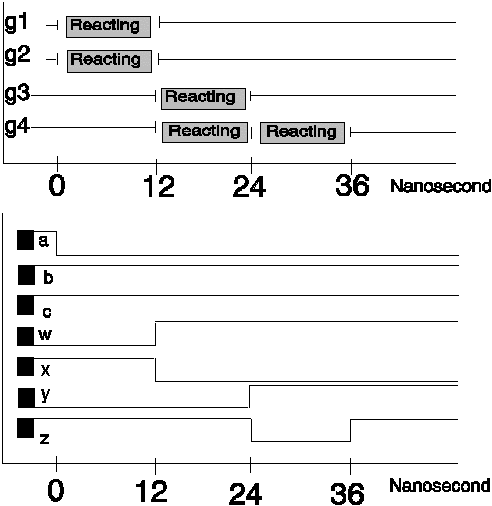
- Proper modeling requires simultaneous processing
- Waveform shows node values
VHDL_Timing.objects_and_classes
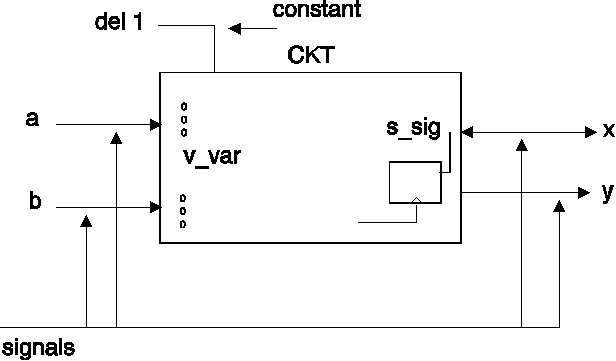
- Signals for hardware carriers
- Variables as temporary carriers
- Constants for fixed parameters
- A signal is an object whose class is signal
VHDL_Timing.signals_and_variables
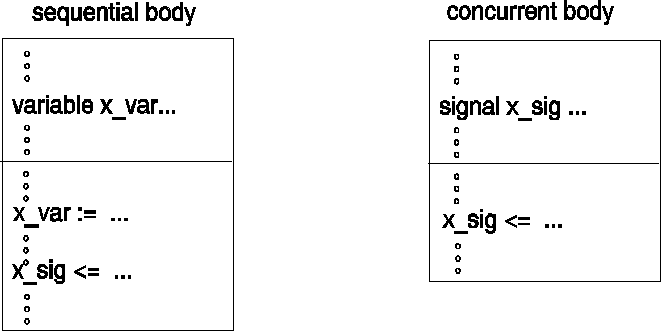
- Signal assignments have a time component
- x_sig <= value AFTER 6 NS;
VHDL_Timing.concurrent/sequential_assignments
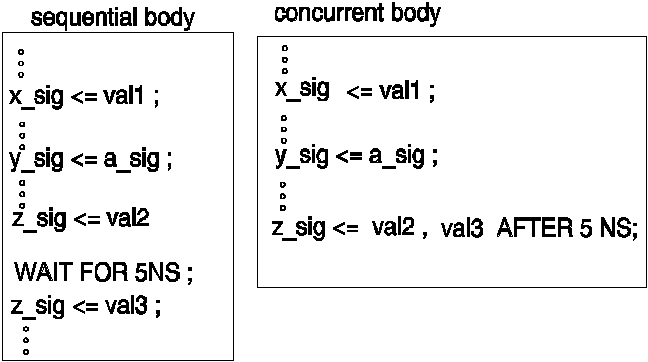
- val2 and val3 are sequentially placed on z_sig
- Assignment of a_sig to y_sig is done:
- in the concurrent body, when event occurs on a_sig
- in the sequential body, when program flow reaches it
VHDL_Timing.concurrent/sequential_assignments
- ENTITY example IS
- PORT (a, b, c : IN BIT ; z : OUT BIT);
- END example;
- --
- ARCHITECTURE concurrent OF example IS
- SIGNAL w, x, y : BIT;
- BEGIN
- w <= NOT a AFTER 12 NS;
- x <= a AND b AFTER 12 NS;
- y <= c AND w AFTER 12 NS;
- z <= x OR y AFTER 12 NS;
- END concurrent;
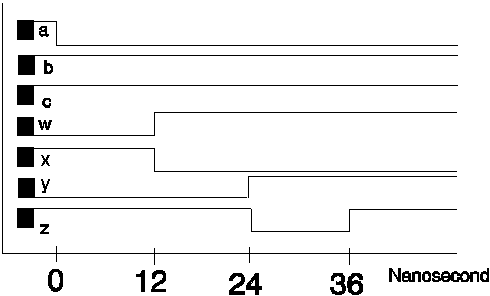
- A concurrency example
- Properly model gate level circuit by concurrency
- Assume a changes from '1' to '0' at time 0
VHDL_Timing.events, transactions, delta_delay

- A signal assignment causes the placement of a transaction on the driver of the left hand side signal
Transaction Representation: (value , time)
- A transaction has a value and a time component
- The time component of a transaction continuously decreases
- Transaction is expired when its time component reaches 0
- A signal receives value when a transaction on its driver expires
VHDL Timing.events, transactions, delta_delay

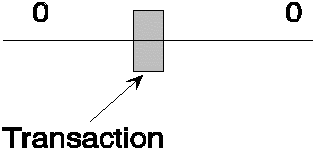
- Assignment to a signal causes an EVENT on the signal if the signal changes value
- An assignment creates a transaction on a signal if the value of the signal does not change
VHDL_Timing.events, transactions, delta_delays
- ARCHITECTURE demo OF example IS
- SIGNAL a, b, c : BIT := '0';
- BEGIN
- a <= '1' AFTER 15 NS; b <= NOT a AFTER 5 NS; c <= a AFTER 10 NS;
- END demo;
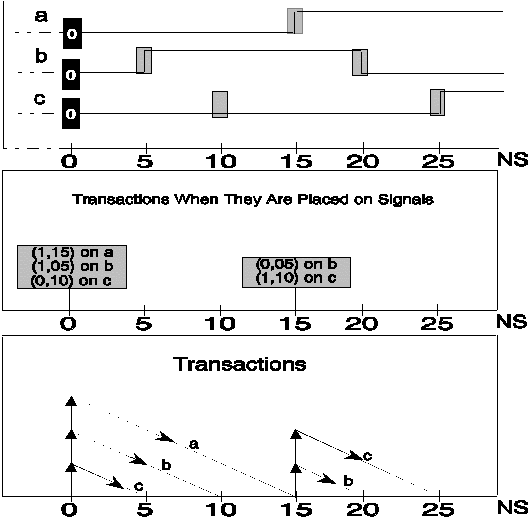
- Example shows events and transactions
- Concurrent assignment on a, b, and c
VHDL_Timing.events, transactions, delta_delays
A transaction with zero time expires a delta after it is placed on the driver on a signal
- delta d
- Delta is a simulation cycle , and not a real time
- Delta is used for scheduling
- A million deltas do not add to a femto second
- Various forms of delta: Delta d d +1
VHDL_Timing.events, transactions, delta_delays
- ARCHITECTURE not_properly_timed OF example IS
- SIGNAL w, x, y : BIT := '0';
- BEGIN
- y <= c AND w;
- w <= NOT a;
- x <= a AND b;
- z <= x OR y AFTER 36 NS;
- END not_properly_timed;
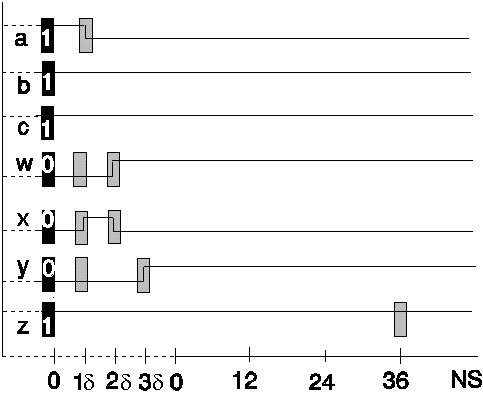
VHDL_Timing.events, transactions, delta_delays
- ARCHITECTURE concurrent OF timing_demo IS
- SIGNAL a, b, c : BIT := '0';
- BEGIN
- a <= '1';
- b <= NOT a;
- c <= NOT b;
- END concurrent;
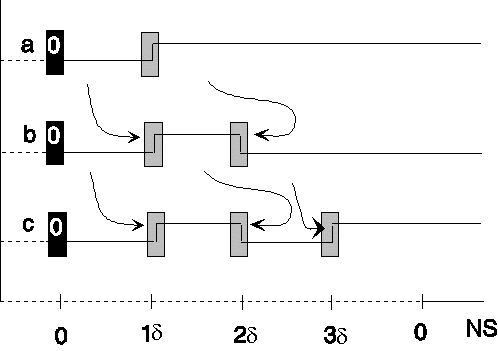
- Another delta example
- Zero real time is spent from change on a until c stabilizes
VHDL_Timing.events, transactions, delta_delays
x <= y
- y <= NOT X
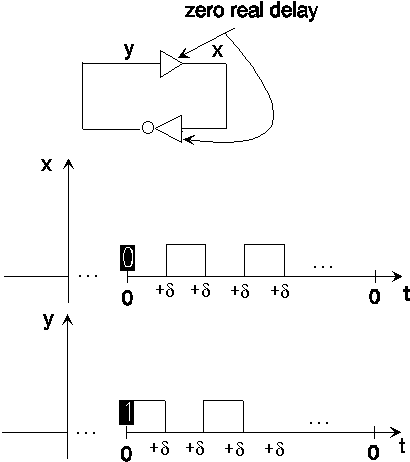
- An interesting example
- Assignments model zero delay inverter/buffer connection
- Oscillation continues forever in zero real time
VHDL_Timing.delay_modeling
- ARCHITECTURE delay OF example IS
- SIGNAL target1, target2, waveform : BIT;
- -- this is a comment
- BEGIN
- -- the following illustrates inertial delay
- target1 <= waveform AFTER 5 NS;
- -- the following illustrates transport delay
- target2 <= TRANSPORT waveform AFTER 5 NS;
- END delay;
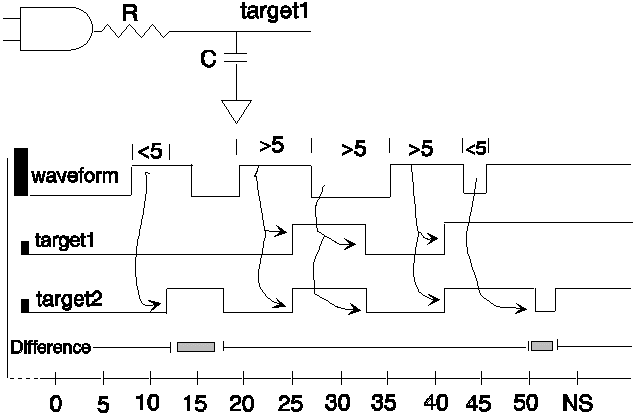
- Inertial delay model represents hardware inertial delay
- Transport delay model is used ingeneration waveforms
VHDL_Timing.sequential_placement_of_transactions

- t1 < t2 < t3

- Sequential placement of transactions justifies delay model
- New transaction AFTER (u1, t1)
- New transaction BEFORE (u3, t3)
- Can use process to place transactions sequentially
VHDL_Timing.sequential_placement_of_transactions
- EXAMPLES for:
- Inertial / Before
- Inertial / After / Different values
- Inertial / After / Same values
- Transport / Before
- Transport / After
- Assume x takes '0', '1', and 'Z' values
ARCHITECTURE sequential OF overwriting_old IS
SIGNAL x : tit := 'Z';
BEGIN
PROCESS BEGIN
x <= '1' AFTER 5 NS; x <= '0' AFTER 3 NS;
WAIT;
END PROCESS;
END sequential;

- Inertial, new transaction BEFORE already existing
- Overwrites already existing
VHDL_Timing.sequential_placement_of_transactions
ARCHITECTURE sequential OF discarding_old IS
SIGNAL x : tit := 'Z';
BEGIN
PROCESS BEGIN
x <= '1' AFTER 5 NS; x <= '0' AFTER 8 NS;
WAIT;
END PROCESS;
END sequential;

- ARCHITECTURE sequential OF saving_all IS
- SIGNAL x : tit := 'Z';
- BEGIN
- PROCESS BEGIN
- x <= '0' AFTER 5 NS; x <= '0' AFTER 8 NS;
- WAIT;
- END PROCESS;
- END sequential;

- Inertial, new transaction AFTER existing, different values
- Inertial, new transaction AFTER existing, same values
VHDL_Timing.sequential_placement_of_transactions
- ARCHITECTURE sequential OF discarding_old IS
- SIGNAL x : tit := 'Z';
- BEGIN
- PROCESS BEGIN
- x <= TRANSPORT '1' AFTER 5 NS; x <= TRANSPORT '0' AFTER 8 NS;
- WAIT;
- END PROCESS;
- END sequential;

- ARCHITECTURE sequential OF saving_all IS
- SIGNAL x : tit := 'Z';
- BEGIN
- PROCESS BEGIN
- x <= TRANSPORT '1' AFTER 5 NS; x <= TRANSPORT '0' AFTER 8 NS;
- WAIT;
- END PROCESS;
- END sequential;

- Transport, new transaction BEFORE already existing
- Transport, new transaction AFTER already existing
VHDL_Timing.sequential_placement_of_transactions
- ARCHITECTURE glitch OF inertial_transport_demo IS
- SIGNAL i_target, t_target, a_glitch : BIT := '0';
- BEGIN
- a_glitch <= '1' AFTER 10 NS, '0' AFTER 12 NS;
- i_target <= a_glitch AFTER 5 NS;
- t_target <= TRANSPORT a_glitch AFTER 5 NS;
- END glitch;
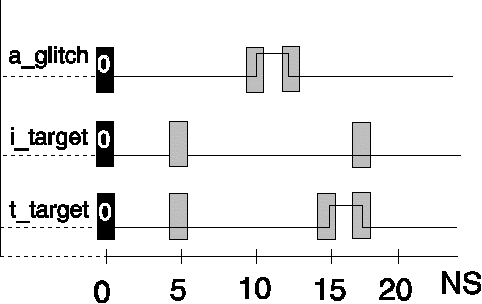
- Sequential placement of transactions causes removal of short glitches in the inertial delay
- VHDL_Timing.convetions & syntax
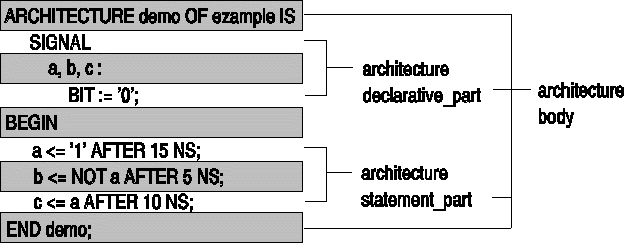
- Syntax details show language constructs
- Use -- (two dashes) for comments
- Use upper case for keywords & predifined words
- VHDL_Timing.conclusion
1. Outline: Introduction, Organization, Outline
2. Review: Behavioral description, Using process statements, Top-down design, Using available components, Wiring predefined components, Wiring from bottom to top, Generation of testbench data, Using procedures
4. Structural_Description_of_Hardware: Wiring parts into larger designs, Start with primitives, Wire gates into general purpose components, Use iterative constructs, Generate testbenches, Show binding alternatives, Use gate-based components for a larger design
5. Design_Organization: Subprograms, Packaging, Parameter specification, Parametrization, Top level configuration, Design libraries, A complete example
6. Utilities_for_high_level_descriptions: Language aspects, Types, Over loading subprograms operators, Predefined Attributes, User defined attributes
7. Dataflow: Constructs for dataflow descriptions, Multiplexing and clocking, Multiple assignments, State machines, Open collector gates, A complete dataflow example, Load dependent timing
8. Behavioral_Descriptions: Constructs for sequential descriptions, Assertion for behavioral checks, Handshaking constructs, Timing control, Formatted I/O, MSI parts, A complete MSI based design
9. STANDARDS: MVL9: logic value system, Logic type, Operators, Conversions; VHDL'93: Operators, Delay model, Instantiation, Binding, Attributes, Signal assignments, Report, Postponed process
to the top of the Document
























